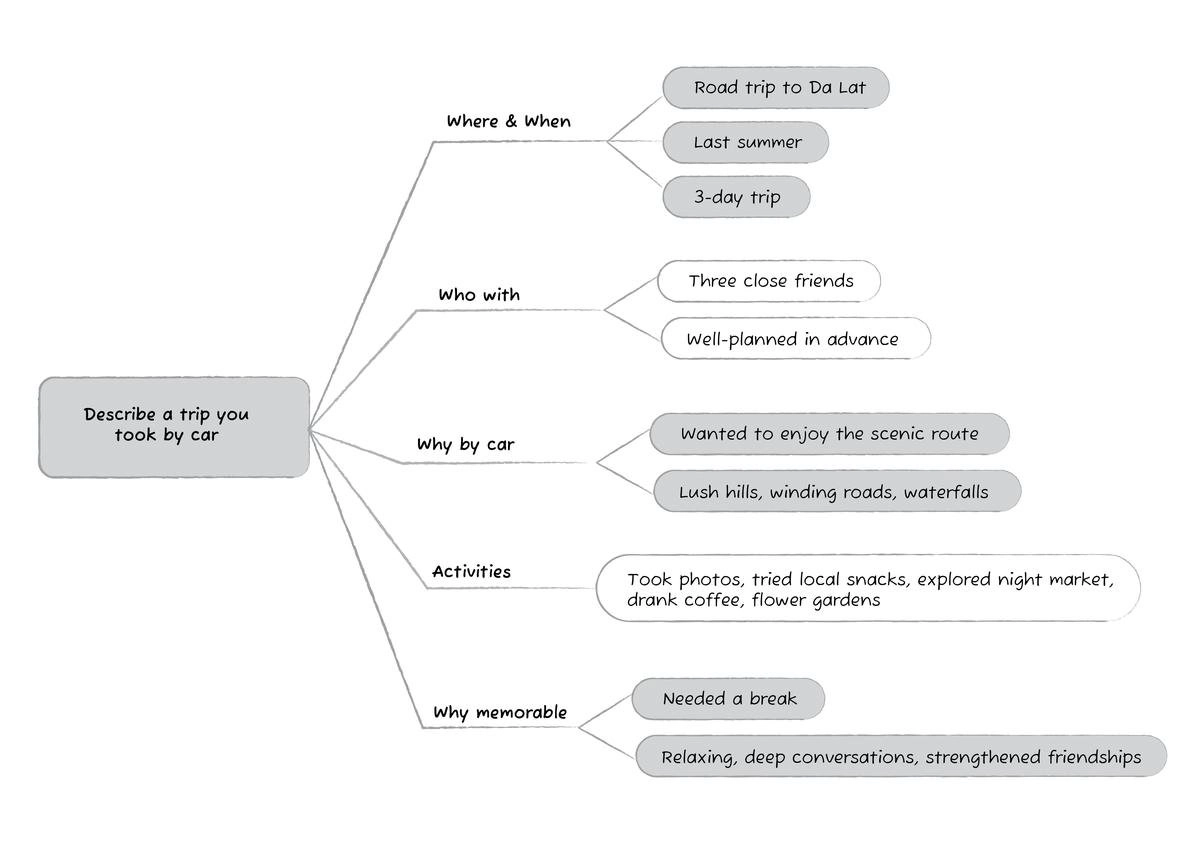Describe a trip you took by car - Bài mẫu IELTS Speaking
Key takeaways
Part 2: A car trip
Trip to Da Lat last summer with 3 friends
Drove to enjoy scenic route
Took photos, ate snacks, visited gardens
Felt relaxed, closer to friends
Part 3: Driving & Transport
Driving needs focus, can be tiring
Good drivers: calm, quick reflexes
Stricter laws = safer roads
Public transport: cheap but crowded
Own car: more freedom, less hassle
Trong kỳ thi IELTS Speaking, đề bài “Describe a trip you took by car” thuộc nhóm chủ đề Travel & Transportation - một trong những chủ đề phổ biến và dễ gặp nhất ở Part 2. Tuy nhiên, nhiều thí sinh vẫn gặp khó khăn trong việc tổ chức ý tưởng mạch lạc, sử dụng từ vựng đa dạng và diễn đạt trôi chảy trong 2 phút nói liên tục.
Bài viết này cung cấp phân tích chi tiết về đề bài, dàn ý chuẩn, bài mẫu band 7.0+ và kho từ vựng chuyên biệt giúp thí sinh xây dựng câu trả lời ấn tượng. Đặc biệt, phần Part 3 sẽ trang bị các câu hỏi mở rộng về luật giao thông, lợi ích của việc lái xe và xu hướng phương tiện di chuyển hiện đại - giúp người học chuẩn bị toàn diện cho phần thảo luận sâu với giám khảo.
Bài mẫu chủ đề “Describe a trip you took by car”
You should say:
When it happened and where you went
Who you travelled with
What you did during the trip
And explain how you felt about the experience.
1. Analyze – Phân tích đề bài
Đề bài: Describe a trip you took by car

Từ khóa quan trọng (Từ trong đề):
Trip by car: Chuyến đi bằng ô tô
Travelled with: Đi cùng ai
What you did: Làm gì trong chuyến đi
How you felt: Cảm xúc về trải nghiệm
2. Craft – Dàn ý & Từ vựng chủ đề

3. Execute – Bài nói mẫu
"Alright, I’d love to tell you about a road trip I went on last summer that left a lasting impression on me."
"So basically, it was a 3-day car trip to Da Lat, which is a charming city in the mountains, about 300 kilometers from Ho Chi Minh City. My travel buddies were three close friends of mine, and we’d been planning it for weeks."
"We decided to drive instead of flying because we wanted to take in the scenery along the way. Honestly, the scenic route was absolutely stunning — lush green hills, winding roads, and even a waterfall or two."
"During the trip, we stopped frequently to take photos, grab some local snacks, and just enjoy the peaceful atmosphere. Once we arrived in Da Lat, we explored the night market, drank amazing coffee, and visited some beautiful flower gardens."
"To be completely honest, the whole trip was exactly what I needed at the time. It helped me get away from it all and really recharge my batteries. What made it even more special was the time I got to spend with my friends — we laughed a lot, had deep conversations, and shared unforgettable memories."
"All in all, it was not just a relaxing vacation, but also a bonding experience that brought us closer together. I’d definitely do it again in a heartbeat."
Tham khảo thêm:
Analyze Useful Vocab – Theo chủ đề
1. Loại chuyến đi & địa điểm
Từ/Cụm từ | Nghĩa | Ví dụ ngữ cảnh mới |
Road trip | Chuyến đi đường dài bằng ô tô | We’re planning a road trip along the coast next month. |
Scenic route | Tuyến đường có cảnh đẹp | Taking the scenic route gave us time to admire the landscape. |
2. Trải nghiệm và cảm xúc
Từ/Cụm từ | Nghĩa | Ví dụ ngữ cảnh mới |
Take in the scenery | Ngắm cảnh | We parked the car and took in the scenery for a while. |
Get away from it all | Tránh xa mọi bộn bề | A trip to the countryside helps me get away from it all. |
Recharge my batteries | Nạp lại năng lượng | A long weekend is perfect for recharging my batteries. |
3. Mối quan hệ & bạn đồng hành
Từ/Cụm từ | Nghĩa | Ví dụ ngữ cảnh mới |
Travel buddies | Bạn đồng hành du lịch | She’s one of my favorite travel buddies because she’s so easygoing. |
Bonding experience | Trải nghiệm gắn kết | The camping trip was such a bonding experience for the whole team. |

Part 3: Discussion Questions – Driving, Laws & Transportation
1. Do you think being a driver is a difficult job? Why or why not?
📌 Point: Yeah, I do think it's a tough job, especially if it’s full-time or done professionally.
📌 Explain: Drivers often have to spend long hours on the road, stay alert the whole time, and deal with stressful situations like traffic, weather, or impatient passengers.
📌 Example: For example, delivery drivers during peak seasons have to meet tight deadlines, which can be both physically and mentally exhausting.
📌 Link: So overall, being a driver definitely demands stamina and focus, making it far from easy.
Vocabulary Highlights:
stay alert
Phát âm: /steɪ əˈlɜːt/
Dịch: Luôn cảnh giác, tỉnh táo
Ví dụ:"Drivers need to stay alert at all times to avoid accidents."
mentally exhausting
Phát âm: /ˈmen.təl.i ɪɡˈzɔː.stɪŋ/
Dịch: Gây mệt mỏi tinh thần
Ví dụ:"Long-distance driving can be mentally exhausting, especially in bad traffic."
2. What skills or qualities are important for professional drivers?
📌 Point: Well, in my opinion, a good driver needs more than just technical skills.
📌 Explain: They must have strong concentration, good reflexes, and a calm attitude—especially under pressure. Communication skills also matter if they’re working with clients or passengers.
📌 Example: For instance, taxi drivers should not only know the roads but also be polite and patient, even when customers are difficult.
📌 Link: So yeah, both soft skills and driving ability are key for this job.
Vocabulary Highlights:
good reflexes
Phát âm: /ɡʊd ˈriː.fleks.ɪz/
Dịch: Phản xạ tốt
Ví dụ:"Good reflexes help drivers respond quickly to sudden changes on the road."
under pressure
Phát âm: /ˈʌn.də ˈpreʃ.ər/
Dịch: Dưới áp lực
Ví dụ:"Drivers need to stay calm under pressure, especially in emergencies."
3. Should there be stricter laws or training for new drivers? Why?
📌 Point: Absolutely, I think stricter training and laws are necessary, especially for young or inexperienced drivers.
📌 Explain: Driving isn’t just about knowing the rules—it’s about judgement and reaction time, which take practice. Tougher regulations could help reduce traffic accidents.
📌 Example: For example, in some countries, new drivers have to complete a minimum number of supervised hours before they can drive alone.
📌 Link: So yeah, investing more in training would make roads safer for everyone.
Vocabulary Highlights:
tougher regulations
Phát âm: /ˈtʌfər ˌreɡ.jʊˈleɪ.ʃənz/
Dịch: Quy định nghiêm ngặt hơn
Ví dụ:"Tougher regulations could reduce reckless driving."
reaction time
Phát âm: /riˈæk.ʃən taɪm/
Dịch: Thời gian phản ứng
Ví dụ:"Quick reaction time is crucial for preventing accidents."
4. What are the advantages and disadvantages of using public transport?
📌 Point: Well, public transport has both pros and cons, to be honest.
📌 Explain: On the positive side, it’s usually cheaper and better for the environment. But on the downside, it can be crowded, delayed, or less convenient than driving.
📌 Example: Like in big cities, buses and subways are cost-effective, but during rush hour, they can be super packed and uncomfortable.
📌 Link: So yeah, it really depends on the situation and how efficient the system is.
Vocabulary Highlights:
cost-effective
Phát âm: /ˌkɒst.ɪˈfek.tɪv/
Dịch: Hiệu quả về chi phí
Ví dụ:"Public transport is a cost-effective option for daily commuting."
rush hour
Phát âm: /rʌʃ ˈaʊər/
Dịch: Giờ cao điểm
Ví dụ:"Trains during rush hour can be uncomfortably packed."
5. Why do some people still prefer driving their own car instead of using public transport?
📌 Point: That’s a good question. I guess many people value the comfort and freedom that comes with having their own car.
📌 Explain: When you drive, you can leave anytime, take your own route, and avoid the hassle of waiting or dealing with crowds. It’s also more private and sometimes faster.
📌 Example: For example, families with young children often prefer driving because it’s easier to manage everything from strollers to schedules.
📌 Link: So for people who prioritize convenience, owning a car just makes more sense.
Vocabulary Highlights:
the hassle of waiting
Phát âm: /ðə ˈhæs.l̩ əv ˈweɪ.tɪŋ/
Dịch: Phiền phức vì phải chờ đợi
Ví dụ:"Some people avoid buses because they don’t like the hassle of waiting."
prioritize convenience
Phát âm: /praɪˈɒr.ɪ.taɪz kənˈviː.ni.əns/
Dịch: Ưu tiên sự tiện lợi
Ví dụ:"People with busy schedules often prioritize convenience over cost."
Đọc tiếp: Describe a shop or store you often go to - Bài mẫu IELTS Speaking
Tổng kết
Với bài mẫu chi tiết và từ vựng được trình bày ở trên, thí sinh đã có nền tảng vững chắc để tự tin trả lời đề bài "Describe a trip you took by car" một cách tự nhiên và logic. Việc nắm vững cấu trúc bài nói, kết hợp linh hoạt các cụm từ theo chủ đề và luyện tập thường xuyên sẽ giúp người học không chỉ đạt band điểm mong muốn mà còn cải thiện khả năng giao tiếp thực tế.
Để đạt điểm số cao trong kỳ thi IELTS, ngoài nắm vững kiến thức, thí sinh còn phải rèn luyện kỹ năng làm bài với các đề thi thực tế. Khóa học luyện đề IELTS nâng cao tại ZIM Academy giúp học viên từ trình độ 5.5 chinh phục mục tiêu 7.0 - 7.5 thông qua hệ thống đề thi bám sát thực tế, phương pháp phân tích chi tiết và chiến lược trả lời hiệu quả. Liên hệ hotline 1900-2833 nhánh số 1 hoặc chat trực tiếp trên website để được tư vấn chi tiết.

Bình luận - Hỏi đáp